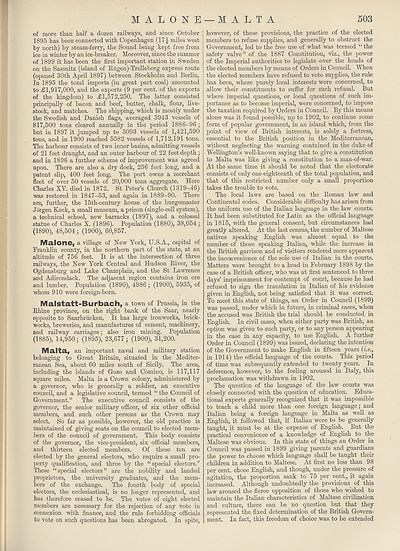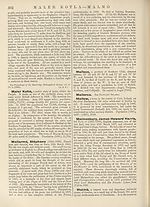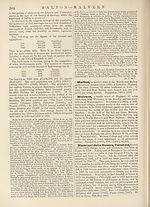New volumes of the Encyclopædia Britannica > Volume 30, K-MOR
(533) Page 503
Download files
Complete book:
Individual page:
Thumbnail gallery: Grid view | List view

503
MALONE
of more than half a dozen railways, and since October
1895 has been connected with Copenhagen (17^ miles west
by north) by steam-ferry, the Sound being kept free from
ice in winter by an ice-breaker. Moreover, since the summer
of 1899 it has been the first important station in Sweden
on the Sassnitz (island of lUigen)-Trelleborg express route
(opened 30th April 1897) between Stockholm and Berlin.
In 1895 the total imports (in great part coal) amounted
to £1,917,000, and the exports (9 per cent, of the exports
of the kingdom) to £1,572,250. The latter consisted
principally of bacon and beef, butter, chalk, flour, live¬
stock, and matches. The shipping, which is mostly under
the Swedish and Danish flags, averaged 3943 vessels of
817,500 tons cleared annually in the period 1886-96 ;
but in 1897 it jumped up to 5093 vessels of 1,421,590
tons, and in 1900 reached 5582 vessels of 1,712,191 tons.
The harbour consists of two inner basins, admitting vessels
of 21 feet draught, and an outer harbour of 22 feet depth;
and in 1896 a further scheme of improvement was agreed
upon. There are also a dry dock, 236 feet long, and a
patent slip, 400 feet long. The port owns a merchant
fleet of over 50 vessels of 20,000 tons aggregate. Here
Charles XY. died in 1872. St Peter’s Church (1319-46)
was restored in 1847-53, and again in 1889-90. There
are, further, the 15th-century house of the burgomaster
Jorgen Kock, a small museum, a prison (single-cell system),
a technical school, new barracks (1897), and a colossal
statue of Charles X. (1896). Population (1880), 38,054;
(1890), 48,504; (1900), 60,857.
Malone, a village of New York, U.S.A., capital of
Franklin county, in the northern part of the state, at an
altitude of 756 feet. It is at the intersection of three
railways, the New York Central and Hudson River, the
Ogdensburg and Lake Champlain, and the St Lawrence
and Adirondack. The adjacent region contains iron ore
and lumber. Population (1890), 4986; (1900), 5935, of
whom 910 were foreign-born.
Ma.lstatt-Burba.Ch, a town of Prussia, in the
Rhine province, on the right bank of the Saar, nearly
opposite to Saarbriicken. It has large ironworks, brick¬
works, breweries, and manufactures of cement, machinery,
and railway carriages; also iron mining. Population
(1885), 14,950; (1895), 23,677; (1900), 31,200.
Malta, an important naval and military station
belonging to Great Britain, situated in the Mediter¬
ranean Sea, about 60 miles south of Sicily. The area,
including the islands of Gozo and Comino, is 117,117
square miles. Malta is a Crown colony, administered by
a governor, who is generally a soldier, an executive
council, and a legislative council, termed “ the Council of
Government.” The executive council consists of the
governor, the senior military officer, of six other official
members, and such other persons as the Crown may
select. So far as possible, however, the old practice is
maintained of giving seats on the council to elected mem¬
bers of the council of government. This body consists
of the governor, the vice-president, six official members,
and thirteen elected members. Of these ten are
elected by the general electors, who require a small pro¬
perty qualification, and three by the “special electors.”
These “special electors” are the nobility and landed
proprietors, the university graduates, and the mem¬
bers of the exchange. The fourth body of special
electors, the ecclesiastical, is no longer represented, and
has therefore ceased to be. The votes of eight elected
members are necessary for the rejection of any vote in
connexion with finance, and the rule forbidding officials
to vote on such questions has been abrogated. In spite,
—MALTA
however, of these provisions, the practice of the elected
members to refuse supplies, and generally to obstruct the
Government, led to the free use of what was termed “ the
safety valve” of the 1887 Constitution, viz., the power
of the Imperial authorities to legislate over the heads of
the elected members by means of Orders in Council. When
the elected members have refused to vote supplies, the rule
has been, where purely local interests were concerned, to
allow their constituents to suffer for such refusal. But
where imperial questions, or local questions of such im¬
portance as to become imperial, were concerned, to impose
the taxation required by Orders in Council. By this means
alone was it found possible, up to 1902, to continue some
form of popular government, in an island which, from the
point of view of British interests, is solely a fortress,
essential to the British position in the Mediterranean,
without neglecting the warning contained in the duke of
Wellington’s well-known saying that to give a constitution
to Malta was like giving a constitution to a man-of-war.
At the same time it should be noted that the electorate
consists of only one-eighteenth of the total population, and
that of this restricted number only a small proportion
takes the trouble to vote.
The local laws are based on the Roman law and
Continental codes. Considerable difficulty has arisen from
the uniform use of the Italian language in the law courts.
It had been substituted for Latin as the official language
in 1815, with the general consent, but circumstances had
greatly altered. At the last census, the number of ^Maltese
natives speaking English was almost equal to the
number of those speaking Italian, while the increase in
the British garrison and of visitors rendered more apparent
the inconvenience of the sole use of Italian in the courts.
Matters were brought to a head in February 1898 by the
case of a British officer, who was at first sentenced to three
days’ imprisonment for contempt of court, because he had
refused to sign the translation in Italian of his evidence
given in English, not being satisfied that it was correct.
To meet this state of things, an Order in Council (1899)
was passed, under which in future, in criminal cases, when
the accused was British the trial should be conducted in
English. In civil cases, when either party was British, an
option was given to such party, or to any person appearing
in the case in any capacity, to use English. A further
Order in Council (1899) was issued, declaring the intention
of the Government to make English in fifteen years {i.e.y
in 1914) the official language of the courts. This period
of time was subsequently extended to twenty years. In
deference, however, to the feeling aroused in Italy, this
proclamation was withdrawn in 1902.
The question of the language of the law courts was
closely connected with the question of education. Educa¬
tional experts generally recognized that it was impossible
to teach a child more than one foreign language; and
Italian being a foreign language in Malta as well as
English, it followed that, if Italian were to be generally
taught, it must be at the expense of English. But the
practical convenience of a knowledge of English to the
Maltese was obvious. In this state of things an Order in
Council was passed in 1899 giving parents and guardians
the power to choose which language shall be taught their
children in addition to Maltese. At first no less than 98
per cent, chose English, and though, under the pressure of
agitation, the proportion sank to 75 per cent., it again
increased. Although undoubtedly the provisions of this
law aroused the fierce opposition of those who wished to
maintain the Italian characteristics of Maltese civilization
and culture, there can be no question but that they
represented the fixed determination of the British Govern¬
ment. In fact, this freedom of choice was to be extended
MALONE
of more than half a dozen railways, and since October
1895 has been connected with Copenhagen (17^ miles west
by north) by steam-ferry, the Sound being kept free from
ice in winter by an ice-breaker. Moreover, since the summer
of 1899 it has been the first important station in Sweden
on the Sassnitz (island of lUigen)-Trelleborg express route
(opened 30th April 1897) between Stockholm and Berlin.
In 1895 the total imports (in great part coal) amounted
to £1,917,000, and the exports (9 per cent, of the exports
of the kingdom) to £1,572,250. The latter consisted
principally of bacon and beef, butter, chalk, flour, live¬
stock, and matches. The shipping, which is mostly under
the Swedish and Danish flags, averaged 3943 vessels of
817,500 tons cleared annually in the period 1886-96 ;
but in 1897 it jumped up to 5093 vessels of 1,421,590
tons, and in 1900 reached 5582 vessels of 1,712,191 tons.
The harbour consists of two inner basins, admitting vessels
of 21 feet draught, and an outer harbour of 22 feet depth;
and in 1896 a further scheme of improvement was agreed
upon. There are also a dry dock, 236 feet long, and a
patent slip, 400 feet long. The port owns a merchant
fleet of over 50 vessels of 20,000 tons aggregate. Here
Charles XY. died in 1872. St Peter’s Church (1319-46)
was restored in 1847-53, and again in 1889-90. There
are, further, the 15th-century house of the burgomaster
Jorgen Kock, a small museum, a prison (single-cell system),
a technical school, new barracks (1897), and a colossal
statue of Charles X. (1896). Population (1880), 38,054;
(1890), 48,504; (1900), 60,857.
Malone, a village of New York, U.S.A., capital of
Franklin county, in the northern part of the state, at an
altitude of 756 feet. It is at the intersection of three
railways, the New York Central and Hudson River, the
Ogdensburg and Lake Champlain, and the St Lawrence
and Adirondack. The adjacent region contains iron ore
and lumber. Population (1890), 4986; (1900), 5935, of
whom 910 were foreign-born.
Ma.lstatt-Burba.Ch, a town of Prussia, in the
Rhine province, on the right bank of the Saar, nearly
opposite to Saarbriicken. It has large ironworks, brick¬
works, breweries, and manufactures of cement, machinery,
and railway carriages; also iron mining. Population
(1885), 14,950; (1895), 23,677; (1900), 31,200.
Malta, an important naval and military station
belonging to Great Britain, situated in the Mediter¬
ranean Sea, about 60 miles south of Sicily. The area,
including the islands of Gozo and Comino, is 117,117
square miles. Malta is a Crown colony, administered by
a governor, who is generally a soldier, an executive
council, and a legislative council, termed “ the Council of
Government.” The executive council consists of the
governor, the senior military officer, of six other official
members, and such other persons as the Crown may
select. So far as possible, however, the old practice is
maintained of giving seats on the council to elected mem¬
bers of the council of government. This body consists
of the governor, the vice-president, six official members,
and thirteen elected members. Of these ten are
elected by the general electors, who require a small pro¬
perty qualification, and three by the “special electors.”
These “special electors” are the nobility and landed
proprietors, the university graduates, and the mem¬
bers of the exchange. The fourth body of special
electors, the ecclesiastical, is no longer represented, and
has therefore ceased to be. The votes of eight elected
members are necessary for the rejection of any vote in
connexion with finance, and the rule forbidding officials
to vote on such questions has been abrogated. In spite,
—MALTA
however, of these provisions, the practice of the elected
members to refuse supplies, and generally to obstruct the
Government, led to the free use of what was termed “ the
safety valve” of the 1887 Constitution, viz., the power
of the Imperial authorities to legislate over the heads of
the elected members by means of Orders in Council. When
the elected members have refused to vote supplies, the rule
has been, where purely local interests were concerned, to
allow their constituents to suffer for such refusal. But
where imperial questions, or local questions of such im¬
portance as to become imperial, were concerned, to impose
the taxation required by Orders in Council. By this means
alone was it found possible, up to 1902, to continue some
form of popular government, in an island which, from the
point of view of British interests, is solely a fortress,
essential to the British position in the Mediterranean,
without neglecting the warning contained in the duke of
Wellington’s well-known saying that to give a constitution
to Malta was like giving a constitution to a man-of-war.
At the same time it should be noted that the electorate
consists of only one-eighteenth of the total population, and
that of this restricted number only a small proportion
takes the trouble to vote.
The local laws are based on the Roman law and
Continental codes. Considerable difficulty has arisen from
the uniform use of the Italian language in the law courts.
It had been substituted for Latin as the official language
in 1815, with the general consent, but circumstances had
greatly altered. At the last census, the number of ^Maltese
natives speaking English was almost equal to the
number of those speaking Italian, while the increase in
the British garrison and of visitors rendered more apparent
the inconvenience of the sole use of Italian in the courts.
Matters were brought to a head in February 1898 by the
case of a British officer, who was at first sentenced to three
days’ imprisonment for contempt of court, because he had
refused to sign the translation in Italian of his evidence
given in English, not being satisfied that it was correct.
To meet this state of things, an Order in Council (1899)
was passed, under which in future, in criminal cases, when
the accused was British the trial should be conducted in
English. In civil cases, when either party was British, an
option was given to such party, or to any person appearing
in the case in any capacity, to use English. A further
Order in Council (1899) was issued, declaring the intention
of the Government to make English in fifteen years {i.e.y
in 1914) the official language of the courts. This period
of time was subsequently extended to twenty years. In
deference, however, to the feeling aroused in Italy, this
proclamation was withdrawn in 1902.
The question of the language of the law courts was
closely connected with the question of education. Educa¬
tional experts generally recognized that it was impossible
to teach a child more than one foreign language; and
Italian being a foreign language in Malta as well as
English, it followed that, if Italian were to be generally
taught, it must be at the expense of English. But the
practical convenience of a knowledge of English to the
Maltese was obvious. In this state of things an Order in
Council was passed in 1899 giving parents and guardians
the power to choose which language shall be taught their
children in addition to Maltese. At first no less than 98
per cent, chose English, and though, under the pressure of
agitation, the proportion sank to 75 per cent., it again
increased. Although undoubtedly the provisions of this
law aroused the fierce opposition of those who wished to
maintain the Italian characteristics of Maltese civilization
and culture, there can be no question but that they
represented the fixed determination of the British Govern¬
ment. In fact, this freedom of choice was to be extended
Set display mode to:
![]() Universal Viewer |
Universal Viewer | ![]() Mirador |
Large image | Transcription
Mirador |
Large image | Transcription
Images and transcriptions on this page, including medium image downloads, may be used under the Creative Commons Attribution 4.0 International Licence unless otherwise stated. ![]()
| Encyclopaedia Britannica > New volumes of the Encyclopædia Britannica > Volume 30, K-MOR > (533) Page 503 |
|---|
| Permanent URL | https://digital.nls.uk/193574430 |
|---|
| Attribution and copyright: |
|
|---|---|
| Shelfmark | EB.18 |
|---|---|
| Description | Ten editions of 'Encyclopaedia Britannica', issued from 1768-1903, in 231 volumes. Originally issued in 100 weekly parts (3 volumes) between 1768 and 1771 by publishers: Colin Macfarquhar and Andrew Bell (Edinburgh); editor: William Smellie: engraver: Andrew Bell. Expanded editions in the 19th century featured more volumes and contributions from leading experts in their fields. Managed and published in Edinburgh up to the 9th edition (25 volumes, from 1875-1889); the 10th edition (1902-1903) re-issued the 9th edition, with 11 supplementary volumes. |
|---|---|
| Additional NLS resources: |
|

